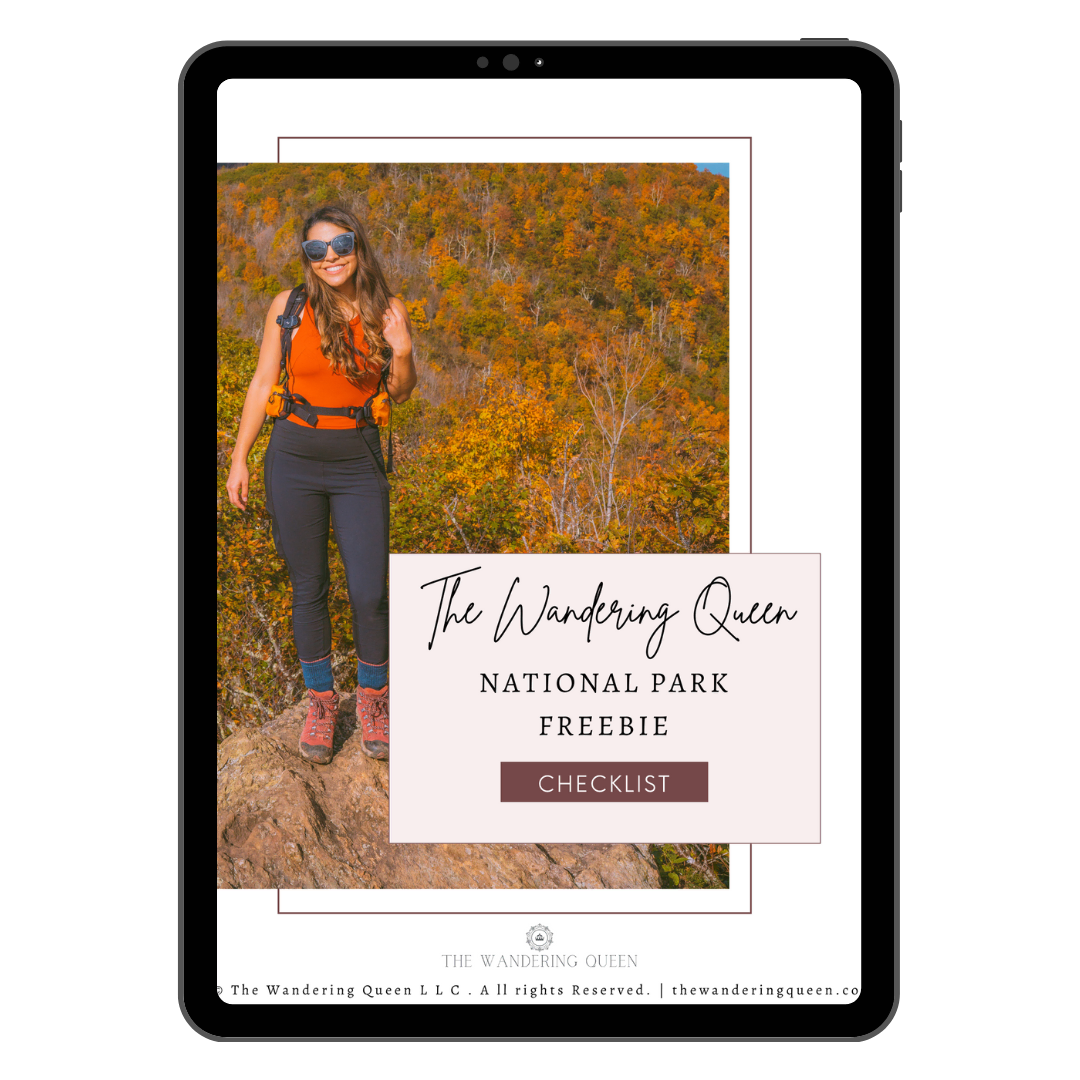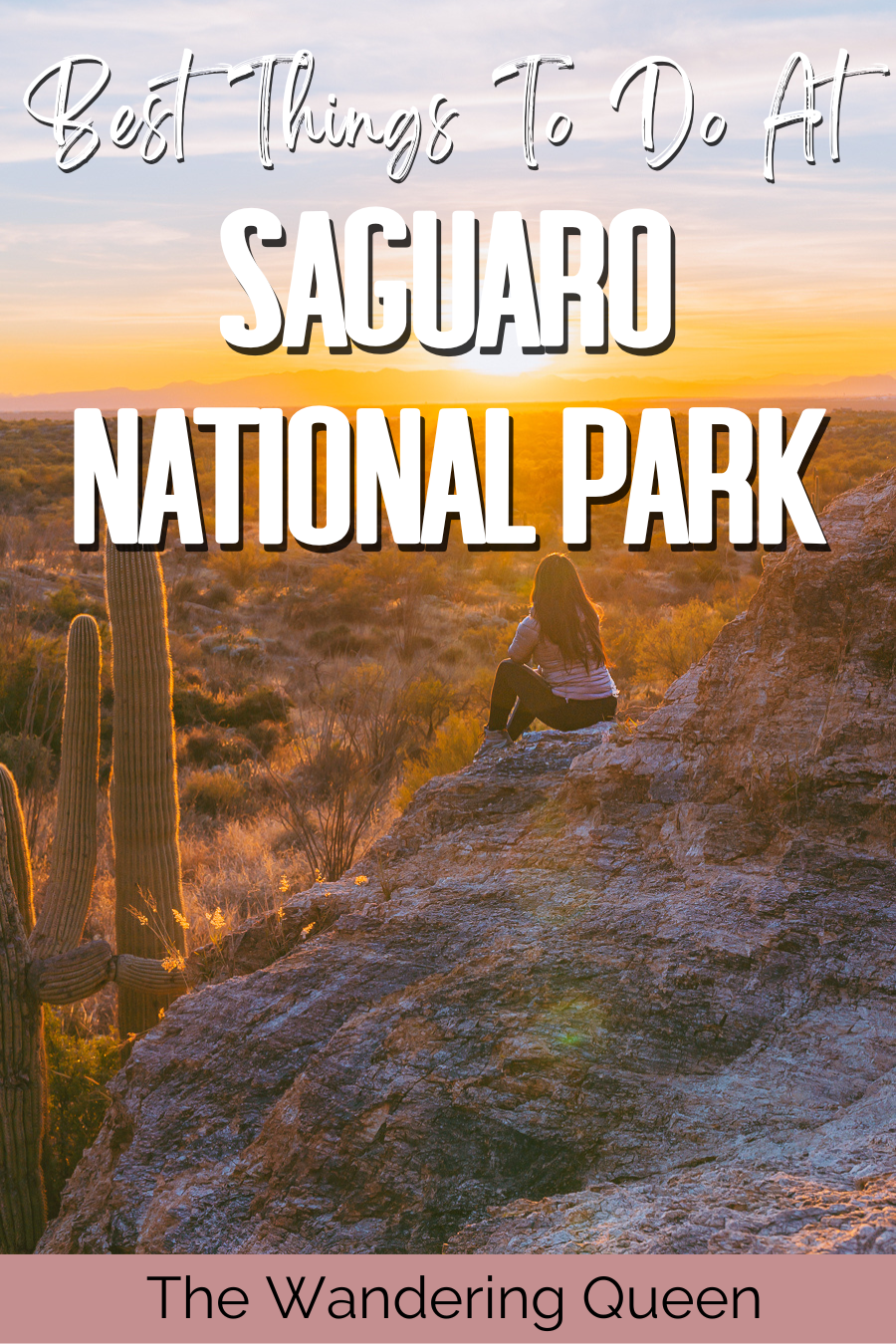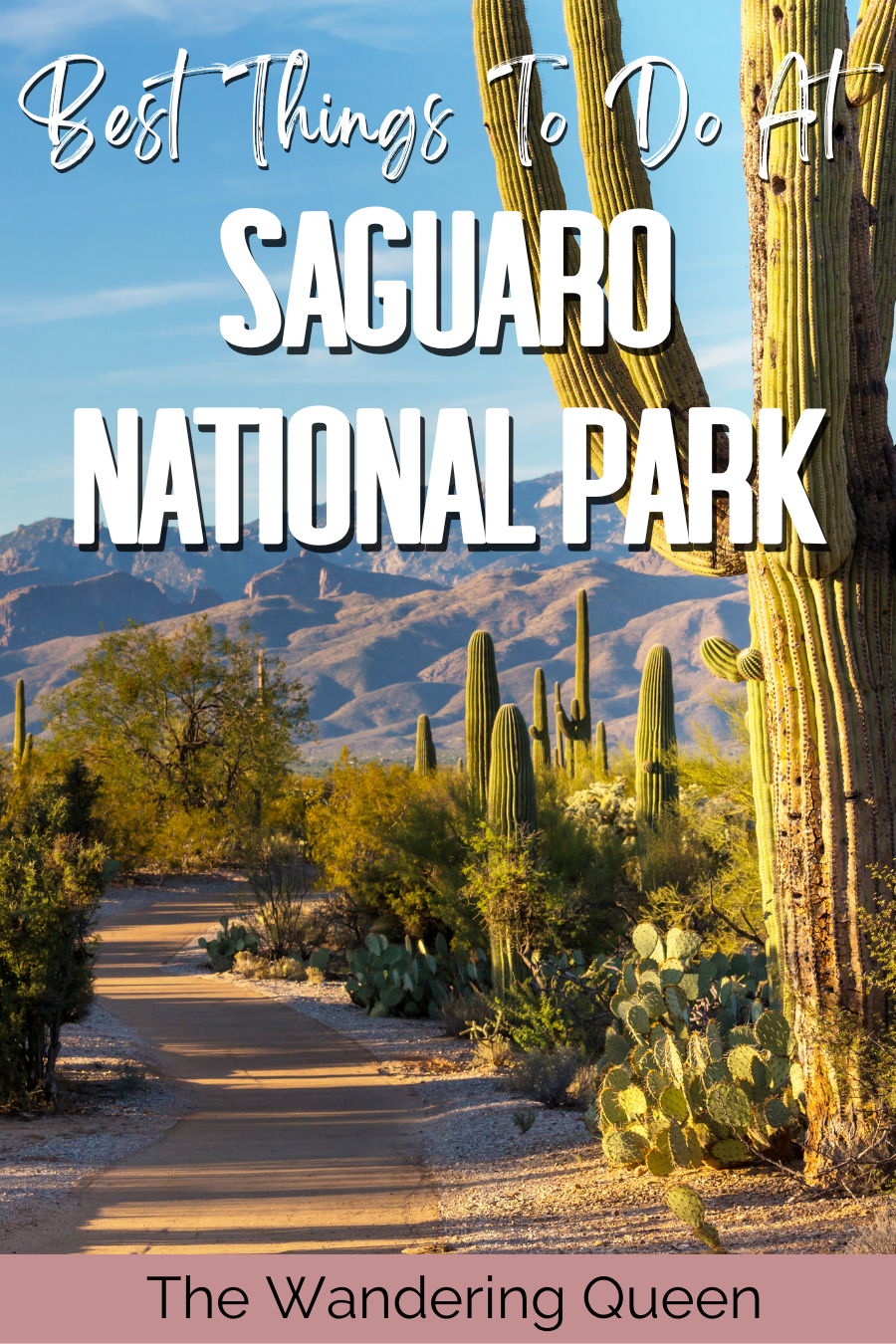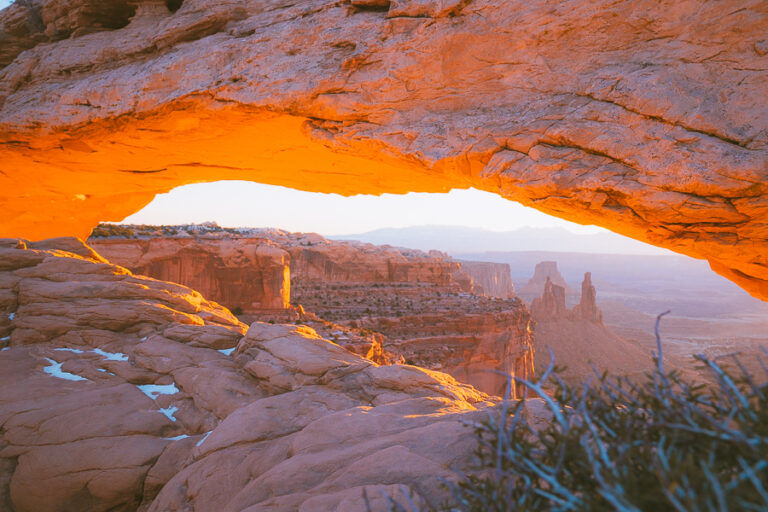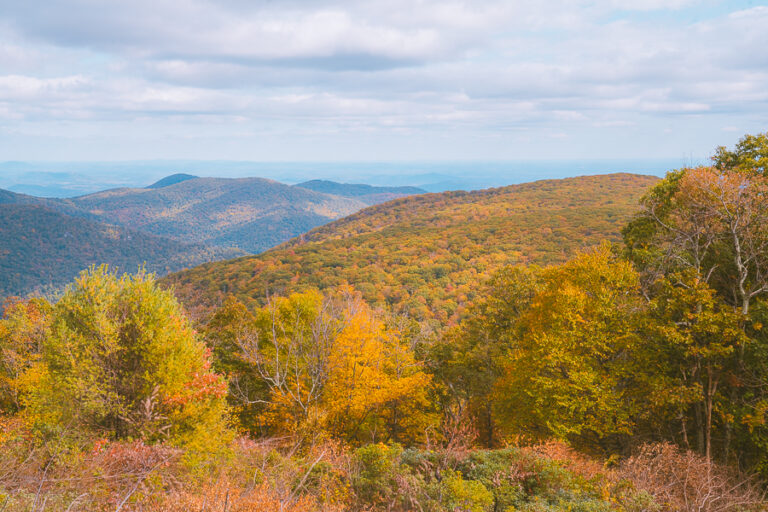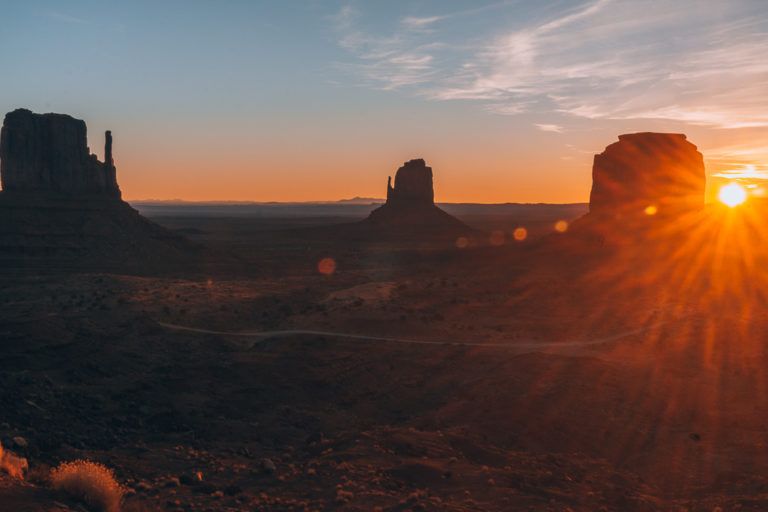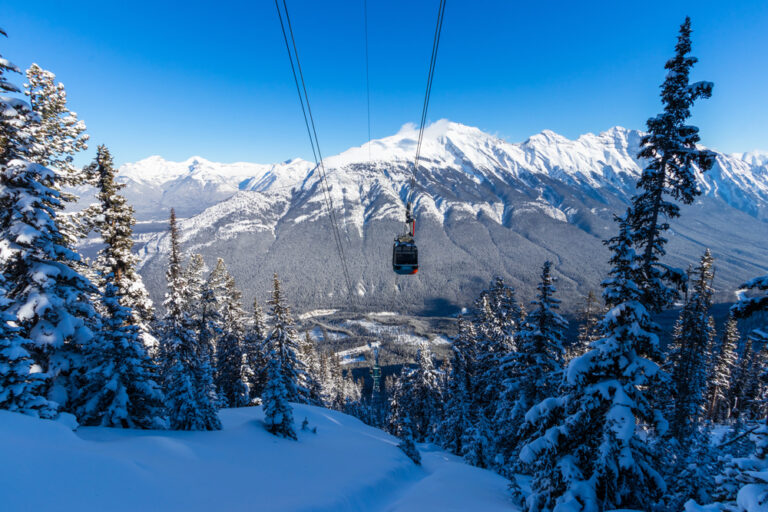15 Best Things to Do in Saguaro National Park When You Visit
Tucked in the arid landscape of Southern Arizona, Saguaro National Park is home to the nation’s largest cacti species. The park’s captivating scenic drives, hiking trails, and historic rock art are undoubtedly among its top attractions, but the towering saguaro cacti are simply hard to beat.
Despite being the major draw, Arizona’s state flower is not the only thing this national park has in store for you. Ranger programs and wildlife sightings are great activities for an immersive experience, while camping and stargazing make for an amazing escape into the Sonoran Desert.
As one of the most-visited Arizona national parks, Saguaro boasts many hikes, stunning overlooks, and picnic areas to keep you entertained for days. That is why visiting Saguaro National Park is a must-add to any Arizona road trip itinerary.
If walking (or driving) among giant saguaro cacti is your idea of a fantastic day outdoors, keep reading. This guide lets you in on all the best things to do in Saguaro National Park.
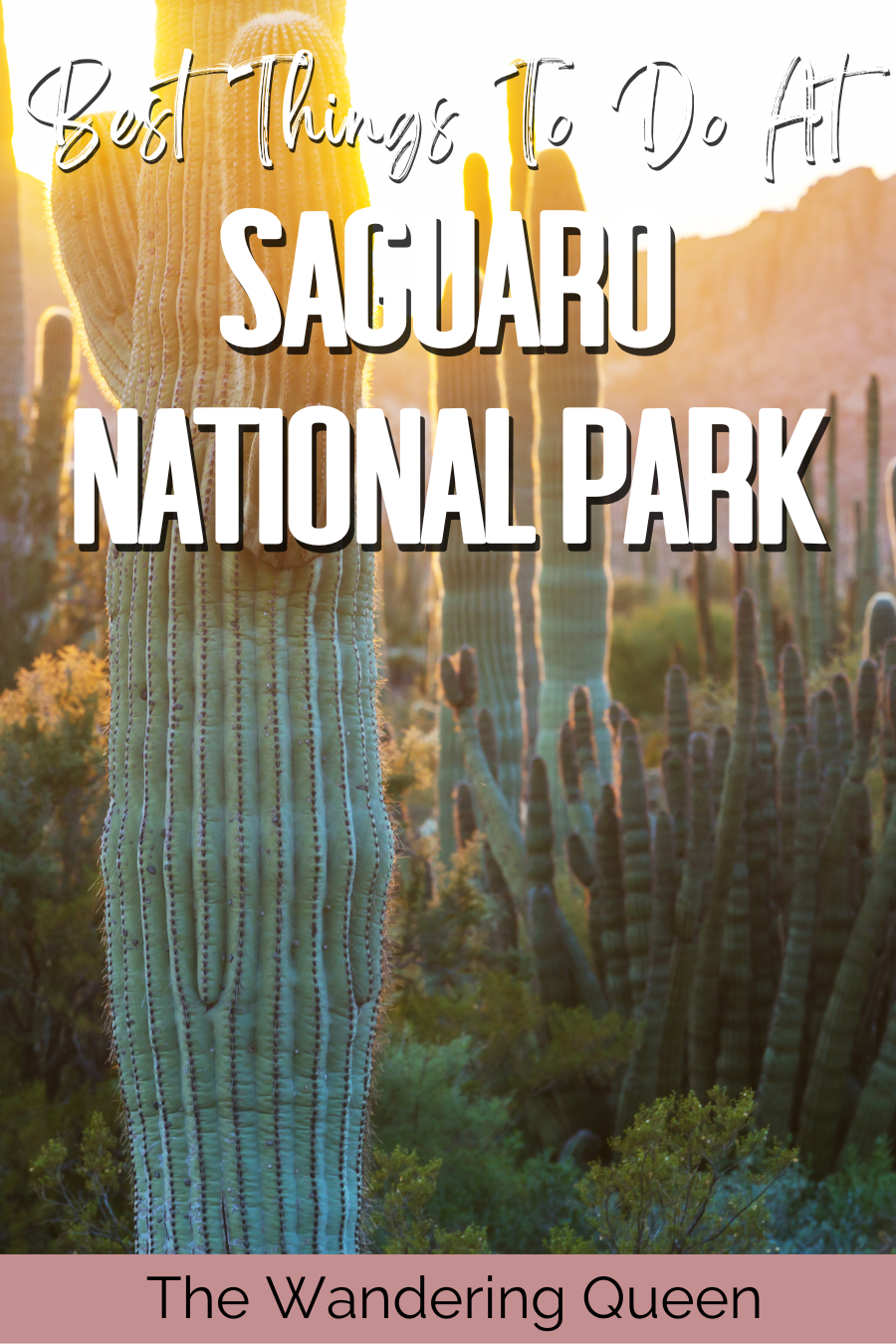
Disclosure: This post contains affiliate links. If you click one of them, I may receive a small commission (for which I am very grateful for) at no extra cost to you.
SAGUARO National Park
Related Posts
Best Time to Visit Saguaro National Park
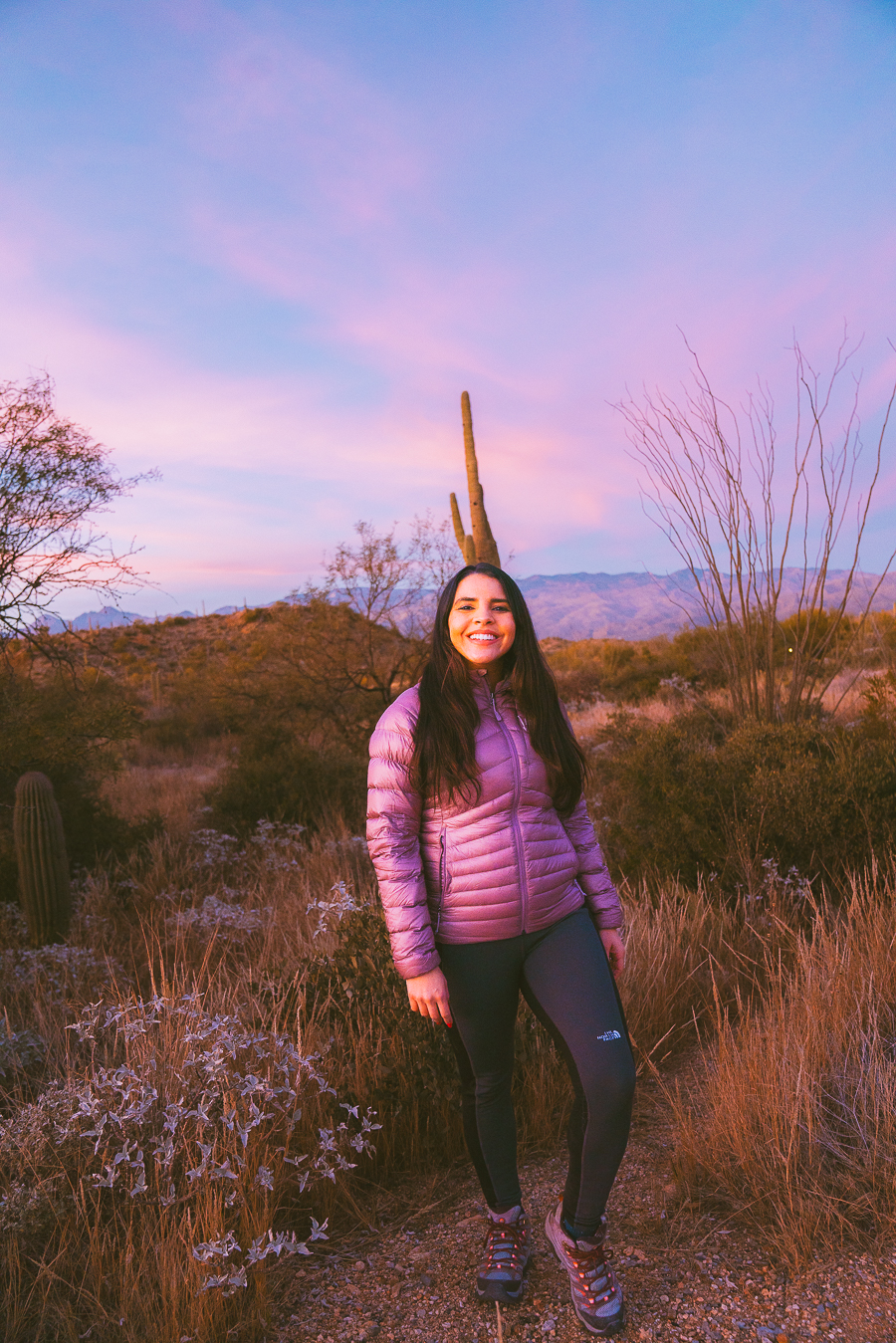
The best time to visit Saguaro National Park depends on your itinerary. Summer often brings hot, sometimes unbearable, daytime temperatures that can easily reach 100°F.
This is also when afternoon showers and thunderstorms (or the monsoon season) sweep in, making summer a good time to visit if you’ll be sticking to scenic drives and short hikes.
Spring is another excellent time to visit. Daytime temperatures typically hover around 75°F, and the blooming desert wildflowers add a vibrant ambiance to the earth-toned Sonoran Desert. Saguaro National Park is also one of the best national parks to visit in the fall.
The park experiences cooler temperatures, with daytime highs ranging from 73°F to 94°F, while the eclectic fall colors of the desert make for great outdoor photography.
Lastly, winter is also a brilliant time to visit Saguaro National Park. With pleasant temperatures reaching around 64°F, the season is ideal for taking long strolls through the cactus garden or strenuous hikes.
Map Of Things to Do in Saguaro National Park
What To Pack For Saguaro National Park
- Sunscreen: Many Saguaro National Park trails do not have any shade, so bringing sun protectants like sunscreen, a sun hat, or a cap is a must. >Buy Sunscreen
- Hiking Boots/Shoes: You’ll need steady and comfortable shoes to trek through the best hikes in Saguaro National Park, as some require climbing and scrambling over boulders. >Check Out My Hiking Shoes
- Hiking socks: Having the correct socks helps you prevent getting blisters. Smart Wool is probably my favorite brand out there. >Buy Hiking Socks
- Refillable water bottle: Temperatures get extremely high in Saguaro National Park, especially in summer, so make sure to bring a bottle to refill at available stations, mainly at the visitor centers >Check Prices Now
- Sunglasses: Protect your eyes with UV-glazed sunglasses.>Check Out These Sunglasses
- Snacks: Bring portable, protein- and energy-rich snacks to keep your energy levels up, especially on longer and more challenging Saguaro National Park hikes. Cliff Bars are great for hiking.
- Trekking Poles: This is an optional product, but they really help with the knees. The poles I have listed are known to be one of the best in the market. >Buy The Trekking Poles Here
- Camera: Bring a digital camera to snap great photos of the most scenic Saguaro National Park hikes and the desert critters you may spot along the way. >Buy Sony Camera Here
- First Aid Kit: This is one of the first things I bought when I started hiking. >Buy This Awesome First Aid Kit Here
- Day Pack: Bring a small but functional bag to fit all your hiking essentials. >Buy This Great Quality Backpack
- Good hiking pants: These are probably the best hiking pants that I have found. >Buy my hiking pants here
- Breathable sweat-wicking shirts: It’s important to go on hikes with the right outfit. Wearing fabric like cotton makes you sweat faster and essentially lose more water. Always opt for breathable and stretchy material. >Check This Shirt Out
- Sports Bra: For women. >Buy One Here
- Jacket: Only in the winter >Buy My Favorite Jacket
- National Park Pass: I highly recommend getting a year-long America The Beautiful Pass. >Get It Here
- Map: I love the National Geographic Maps! They are the best! >Buy One Here
Claim your FREE Hiking Checklist
Ready to start hiking? Grab my free hiking checklist and never forget anything at home!
How Much Time Is Needed in Saguaro National Park
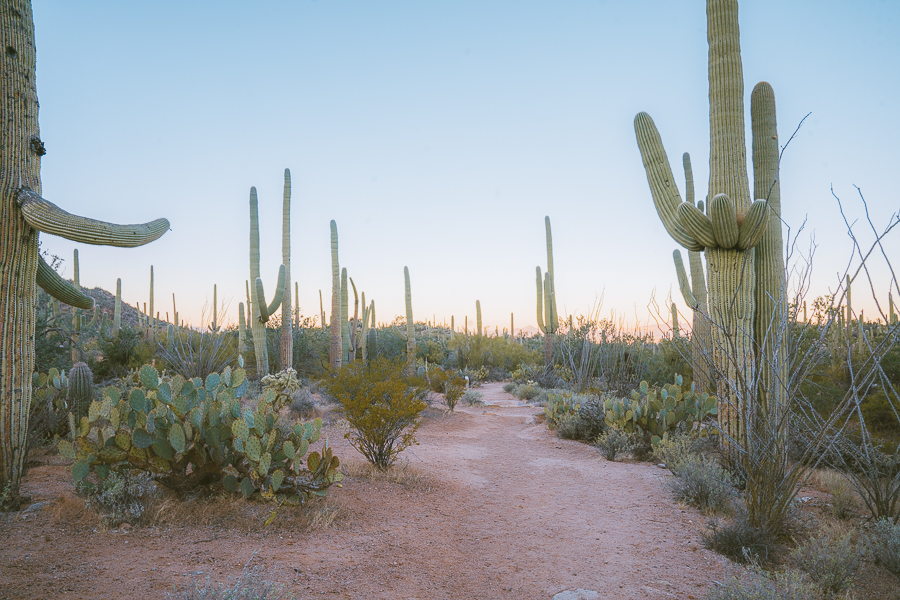
Saguaro National Park is quite unique as it is split in two – Tucson Mountain District and Rincon Mountain District – by a lively Arizona city. So you’ll need at least two days in the park, one to explore each side.
If you have more time or you’ve simply had enough of the desert hiking, spend the rest of your days exploring the city tucked between the two districts. You’ll find plenty of great things to do if you visit Tucson, and make sure you don’t miss out on authentic Mexican food!
How to Get to Saguaro National Park
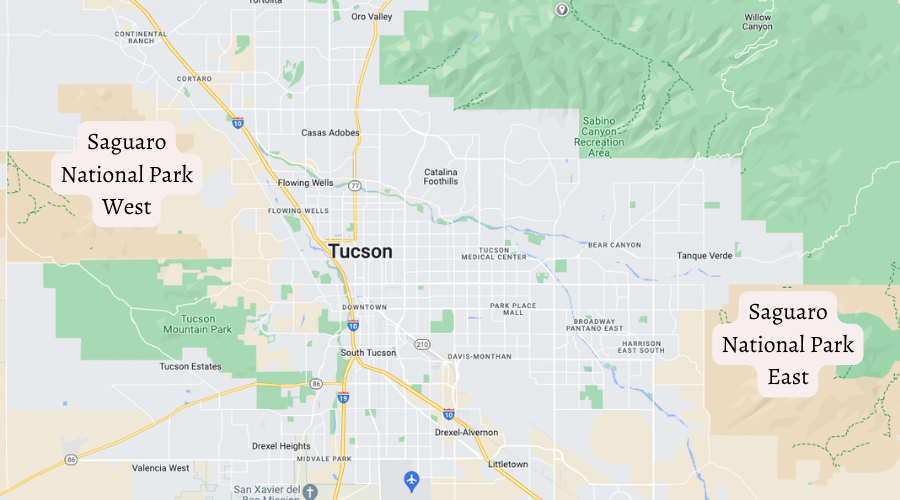
A direct flight to Saguaro National Park sees you landing at Tucson International Airport (TUS), located about eight miles from downtown Tucson. From there, you can pick up your rental car and head to the hotel or just right into the itinerary.
The park’s west district (Tucson) is about a 40-minute drive from the airport, while the east district (Rincon) is almost 30 minutes away. There are other numerous ways to get to Saguaro National Park, especially if you’re visiting from within the state.
Phoenix to Saguaro National Park
From Phoenix, you’ll take Interstate 10 (I-10) east towards Saguaro National Park. The highway leads straight to Tucson, so you won’t need to take any offramps until then. Once in Tucson, take the Houghton Road exit, leading you closer to the Rincon Mountain District.
Scottsdale to Saguaro National Park
If you’re coming from Scottsdale, you’ll begin the journey by heading south on the AZ-101 Loop (or Pima Freeway). Merge onto AZ-202 East and then follow the signs that lead you toward the I-10. From there, exit on Houghton Road and follow the park signs.
Sedona to Saguaro National Park
Start by heading south on AZ-179. This road takes you through the stunning Red Rock Country, where you’ll find many awesome things to do in Sedona. This makes traveling from Sedona one of the most scenic routes to Saguaro National Park. From the AZ-179, merge onto Interstate 17 (I-17) South towards Phoenix, where you’ll get on the I-10 to Tucson.
Places to Stay When Visiting Saguaro National Park
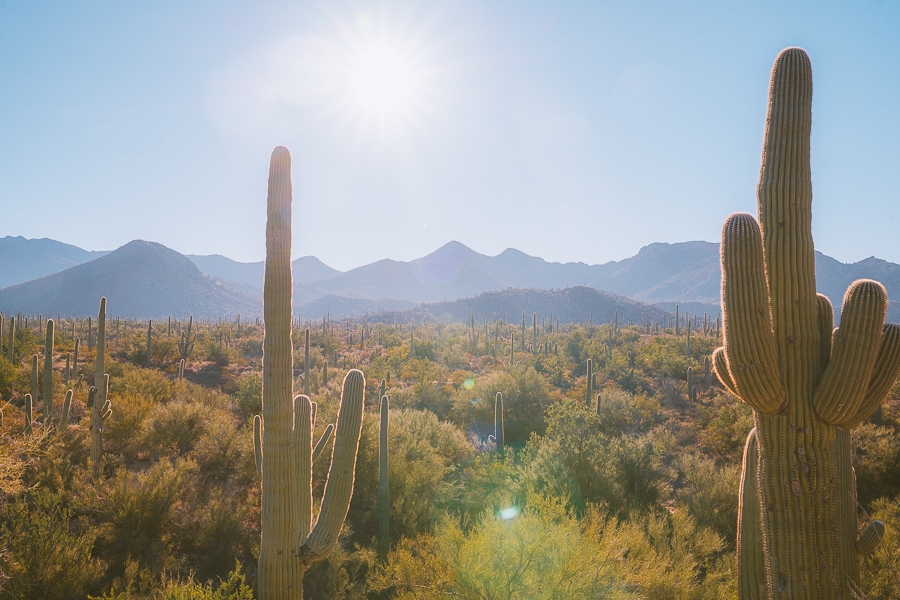
Staying close to a national park is always a good idea. It saves travel time and gives you more time for a full-fledged experience, and Saguaro National Park is no different.
Luckily for you, this national park sits on either side of Tucson, where there are plenty of places to stay.
Camping in Saguaro National Park
Staying overnight at a national park is one of the most authentic ways to experience its attractions. Saguaro National Park has six designated campgrounds, and they are all within the Saguaro Wilderness Area in the Rincon Mountain District.
Keep in mind that all these campsites require hiking as none of them are accessible by car. The campgrounds do not accommodate RV camping, and fire is prohibited in some campsites like Douglas Spring and Grass Shack. You’ll need an $8 permit to stay for a night. >>>View Rates and Availability
Budget | Hotel McCoy – Art, Coffee, Beer, Wine
If you want a sweet escape in the midst of Arizona’s rugged landscape, there is no better place than Hotel McCoy. This 3-star accommodation offers all the mod-cons, from a resort-style pool to a well-equipped fitness center and lots of places to wind down.
On the property, you’ll also find a spot to play table tennis, free bikes to ride around, an expansive garden, and a coffee bar you must stop by. Outside of Hotel McCoy, you can spend time at the Tucson Museum of Art or Reid Park Zoo, both less than four miles away. >>>View Rates and Availability
Mid-Range | Graduate Tucson
For a more authentic experience that won’t leave you roughing it — Graduate Tucson is the perfect place for you to stay. This 4-star hotel not only supplies you with the most sophisticated amenities but also gives you a glimpse of desert luxury.
Vibrantly decorated rooms, a massive dining hall, and an infinity swimming pool with skyline views of the city are a few of Graduate Tucson’s best features. The hotel also offers on-site private parking and free Wi-Fi. >>>View Rates and Availability
Luxury | Casino del Sol Resort
If a luxurious desert experience is what you’re looking for, it doesn’t get any better than Casino del Sol Resort. Located about five miles from Tucson International Airport, this 4-star hotel is very accessible, and once you arrive, you won’t want to leave for a long time.
This resort offers you relaxing treatments and massages at the spa, a large outdoor pool, a fitness center, an on-site casino, and a well-stocked bar where you can grab a few drinks. >>>View Rates and Availability
Read More: Best Hotels Near Saguaro National Park | 10 Amazing Stays
What to Do in Saguaro National Park | 15 Best Attractions & Activities
Saguaro National Park’s Rincon and Tucson Mountain districts both offer amazing outdoor activities that will leave you awestruck. From densely-packed saguaro cactus views to scenic drives and impressive Saguaro National Park hikes, let’s dive into the best things to do.
1. Make a Stop at the Red Hills Visitor Center
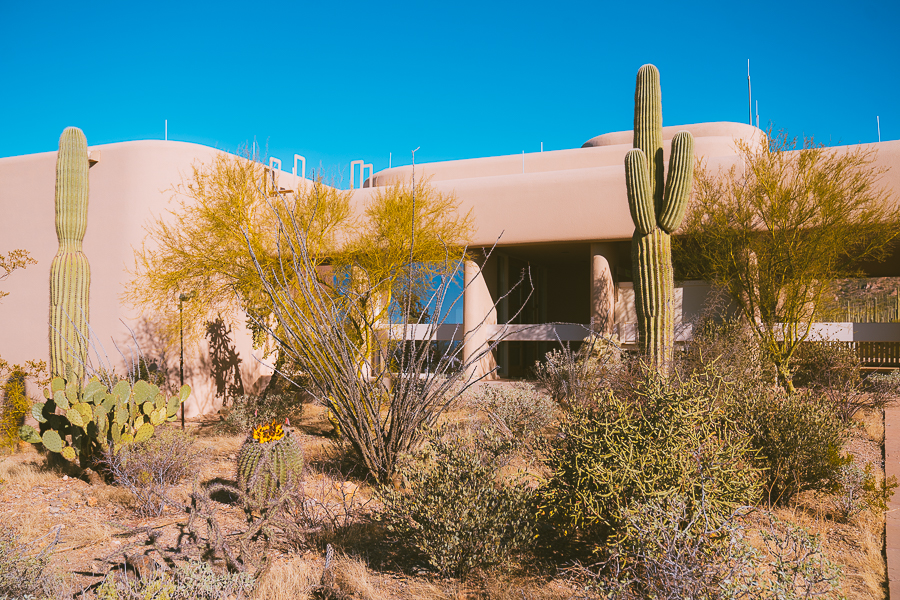
As with any park visit, the best place to kick off your Saguaro National Park itinerary is none other than the visitor center. This park has two visitor centers, one in each district.
You’ll find the Red Hills Visitor Center in the park’s Tucson Mountain District, which is also the side with the most saguaro cacti. Here, you can learn more about the park’s history and ecology. Interactive exhibits, information desks, and helpful park rangers are also available to guide your exploration. >>>Check Opening Times Here
2. Visit the Arizona-Sonora Desert Museum
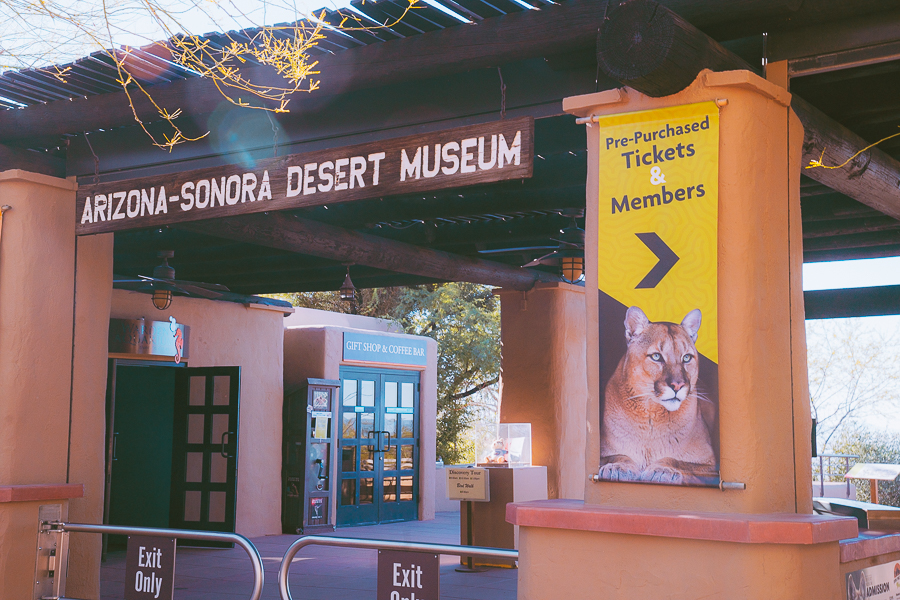
Just a five-minute drive from the Red Hills Visitor Center, you’ll stumble upon the superbly diverse Arizona-Sonora Desert Museum. This 98-acre property offers many attractions, including a zoo, botanical gardens, an aquarium, and an art gallery.
The museum is a fantastic place to see various species of endemic flora and fauna, as well as learn more about the desert ecosystem. Spend time at the museum watching live animal presentations, meeting stingrays, spotting wildlife, or attending ranger programs that share useful insights about the desert environment.
3. Hike to Wasson Peak via King Canyon Trail
- Mileage: 6.9 miles out-and-back
- Elevation Gain: 1,834 feet
- Difficulty: Moderate
- Trail Guide: Link
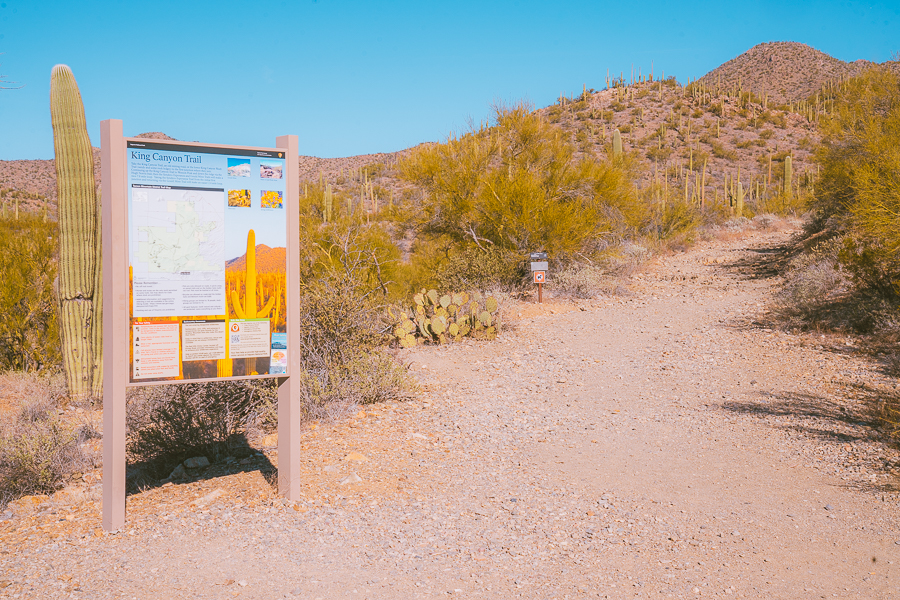
There are many routes you can take to Wasson Peak, and that’s not surprising considering it is the national park’s highest point and a main attraction in Saguaro West. The King Canyon Trail is unshaded and relatively linear, with no crazy switchbacks or upwards scrambles.
At the summit, you get sweeping panoramas of the park with saguaro cacti dotted across the landscape. The trail begins off North Kinney Road, less than a mile from the Arizona-Sonora Desert Museum.
From the parking area, you’ll start your trek to Wasson Peak, and about halfway through the hike, you’ll come across the Mam-A-Gah Picnic Area, where you can take a water break and admire the beautiful surroundings.
4. Take on the Sendero Esperanza Trail
- Mileage: 5 miles out-and-back
- Elevation Gain: 1,040 feet
- Difficulty: Moderate
- Trail Guide: Link
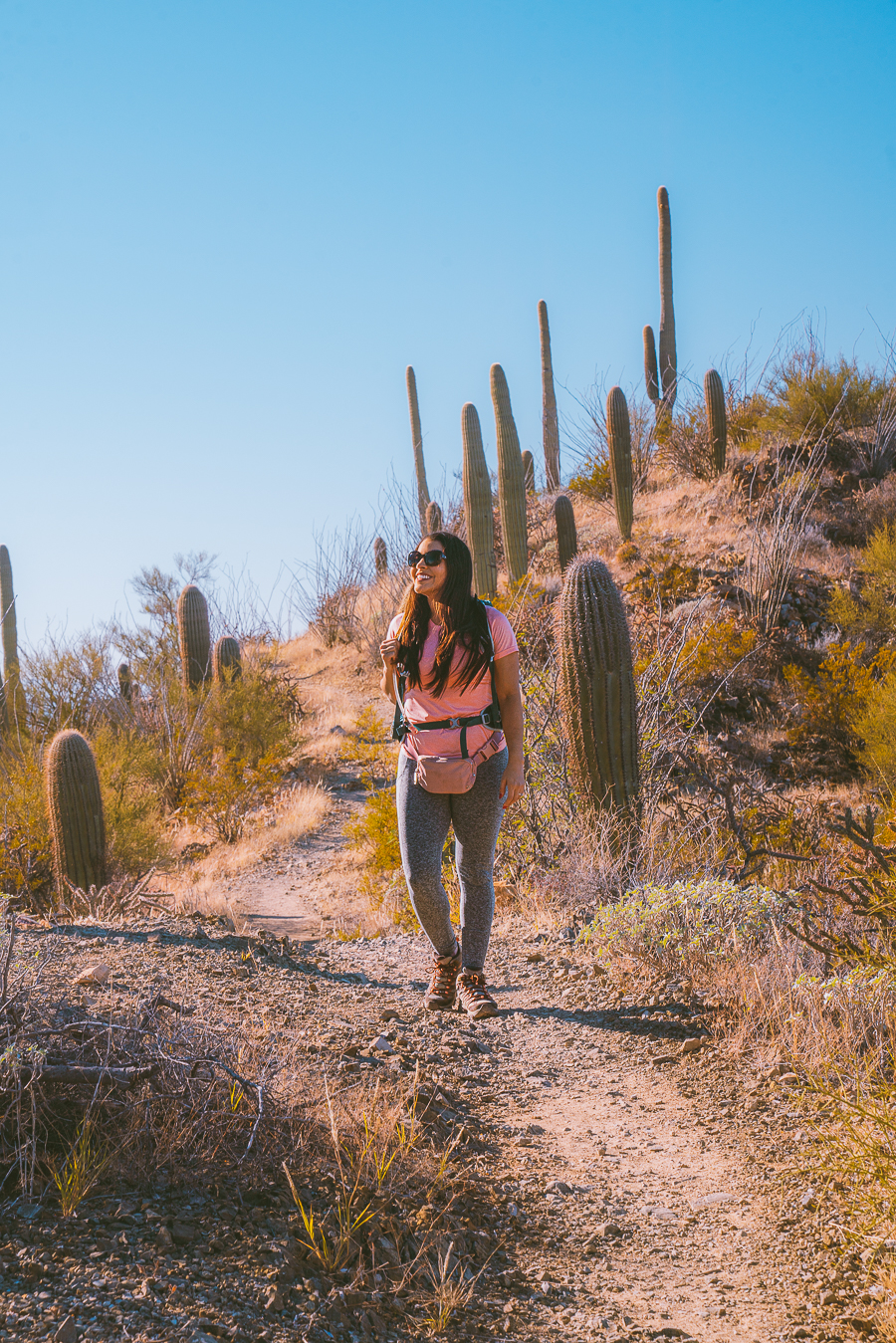
As one of the best hikes in Saguaro National Park, trekking the Sendero Esperanza Trail is among the park’s most famous attractions, and it’s not hard to see why. The trail is filled with colorful wildflowers and prickly pears along the way as it gradually climbs up a ridge that provides you with terrific views of Saguaro National Park West.
This hiking trail also links you to Wasson Peak via the Hugh Norris Trail, but brace yourself for many switchbacks and moderate scrambling. If you start hiking on the King Canyon Trail, you can access the Sendero Esperanza Trail from the Mam-A-Gah Picnic Area.
5. Marvel at the Signal Hill Petroglyphs
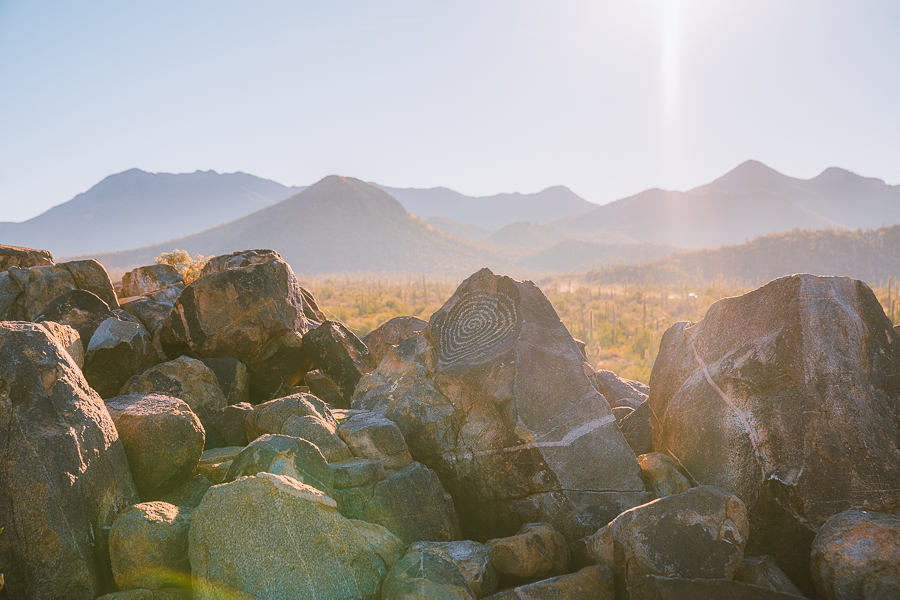
The Signal Hill Area is one of the most unique parts of the park. The ancient petroglyphs found here tell a fascinating story of the Native American tribes who once called Saguaro National Park home approximately between 550 and 1550 years ago.
Signal Hill Petroglyphs can be found on a small, rocky patch of land that’s clearly visible from the ascending trail. However, you’ll need to do a bit of scrambling to get an up-close look. The site has over 200 prehistoric rock art, all giving insight into the life of an indigenous people.
Before you head to your next attraction, consider having lunch at the Signal Hill Picnic Area. This is a great place to stop for a bite, as it offers plenty of shaded benches and awesome vistas of the mountains in West Saguaro.
Grab Your Free Car Camping Checklist! 🚗🌲
Ready to elevate your car camping game? Snag our essential checklist to ensure you’ve got everything you need for a stress-free, fun-filled adventure! Perfect for beginners and seasoned campers alike. Download now and hit the road prepared! 🌟🎒
6. Hike the Valley View Overlook Trail
- Mileage: 0.81 miles out-and-back
- Elevation Gain: 49 feet
- Difficulty: Easy
- Trail Guide: Link
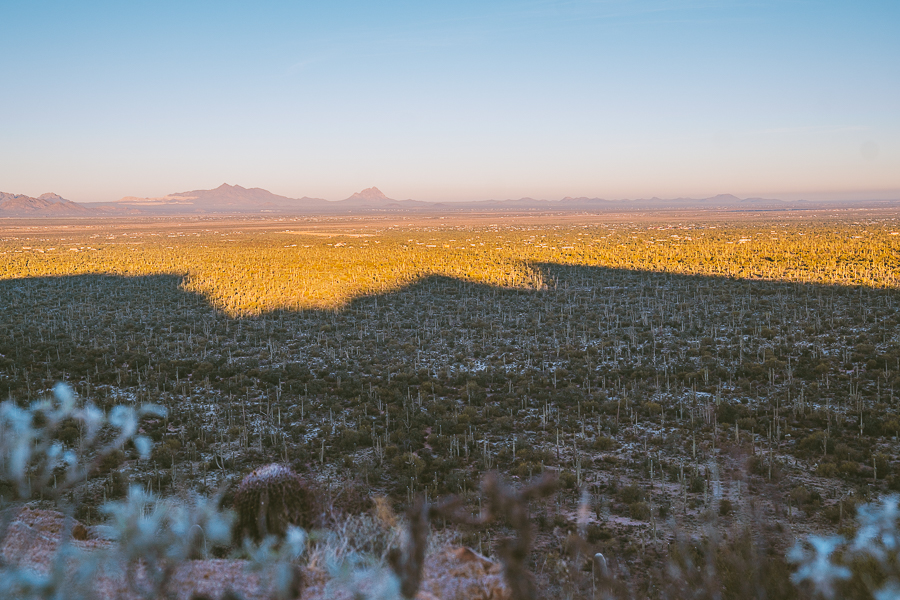
If you’re looking for a short and easy hike that still sees you wandering through towering saguaros, none are as ideal as trekking the Valley View Overlook Trail. The route to Valley View constantly drops in and out of several washes before gradually ascending up a ridge.
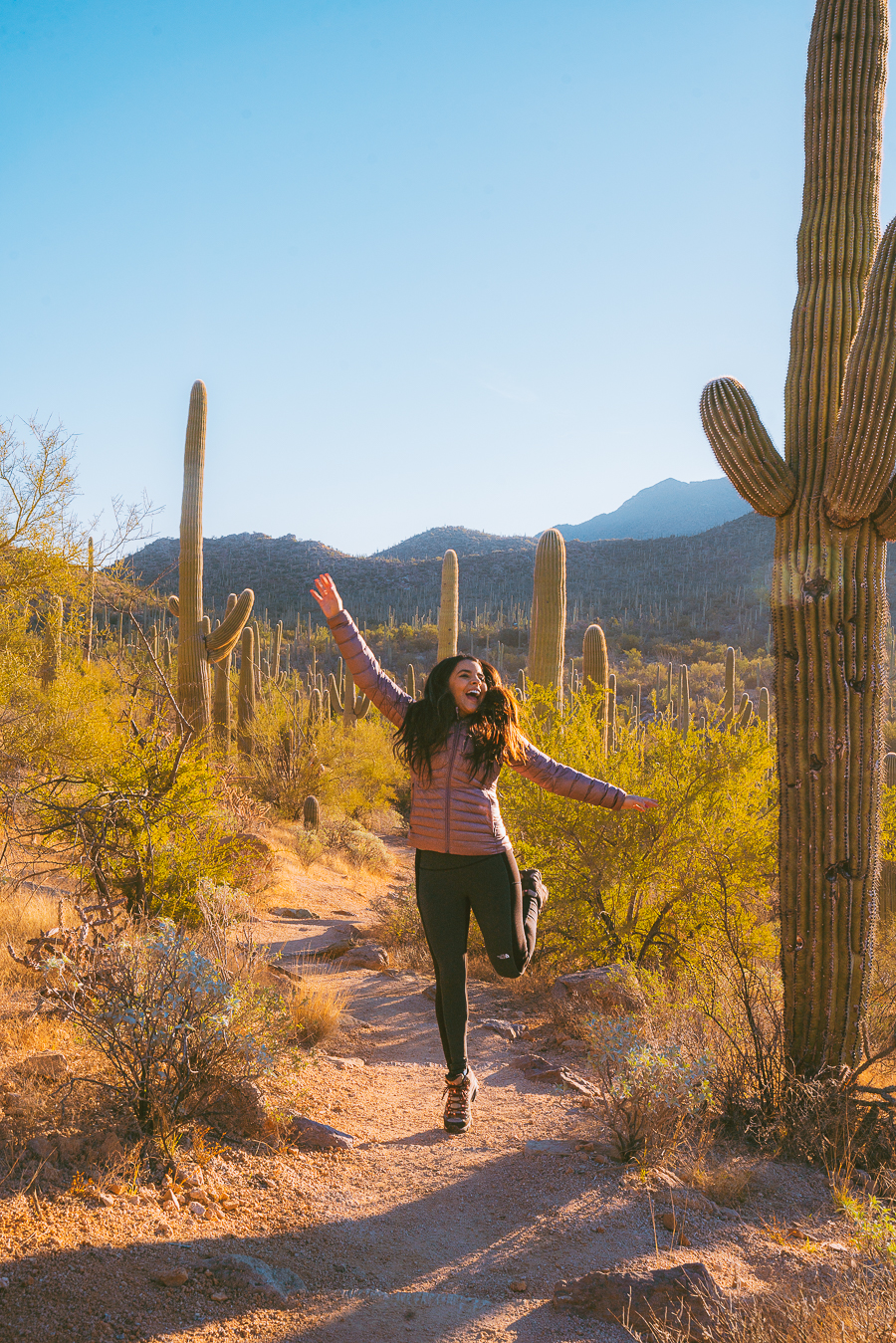
You’ll walk through lush Sonoran Desert vegetation, and don’t forget to stop and read the informational signs about different plant species as you hike to Valley View Overlook. At the end of the Valley View Overlook Trail, you’ll find benches to sit and admire the stunning views of Signal Hill, Avra Valley, and Picacho Peak.
7. Take on the Scenic Bajada Loop Drive
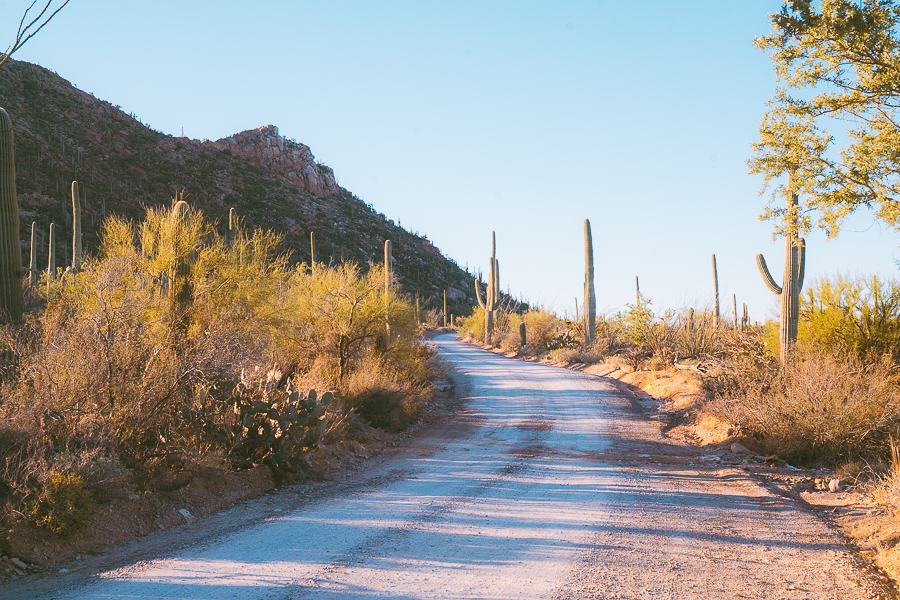
Taking on the Bajada Loop Drive is an excellent way to explore what lies at the foothills of the Tucson Mountains. This unpaved dirt road features many pullouts, hiking trailheads, and runs past two picnic areas. And the best part? You won’t need a 4×4 for this drive.
The Bajada Loop Drive begins along Hohokam Road and ends where Golden Gate Road meets Sandario Road. Bikers will appreciate that this scenic loop also allows biking. And if you are up for cycling, make sure to familiarize yourself with the park’s rules and regulations.
8. Explore the Desert Discovery Nature Trail
- Mileage: 0.37 miles loop
- Elevation Gain: 16.4 feet
- Difficulty: Easy
- Trail Guide: Link
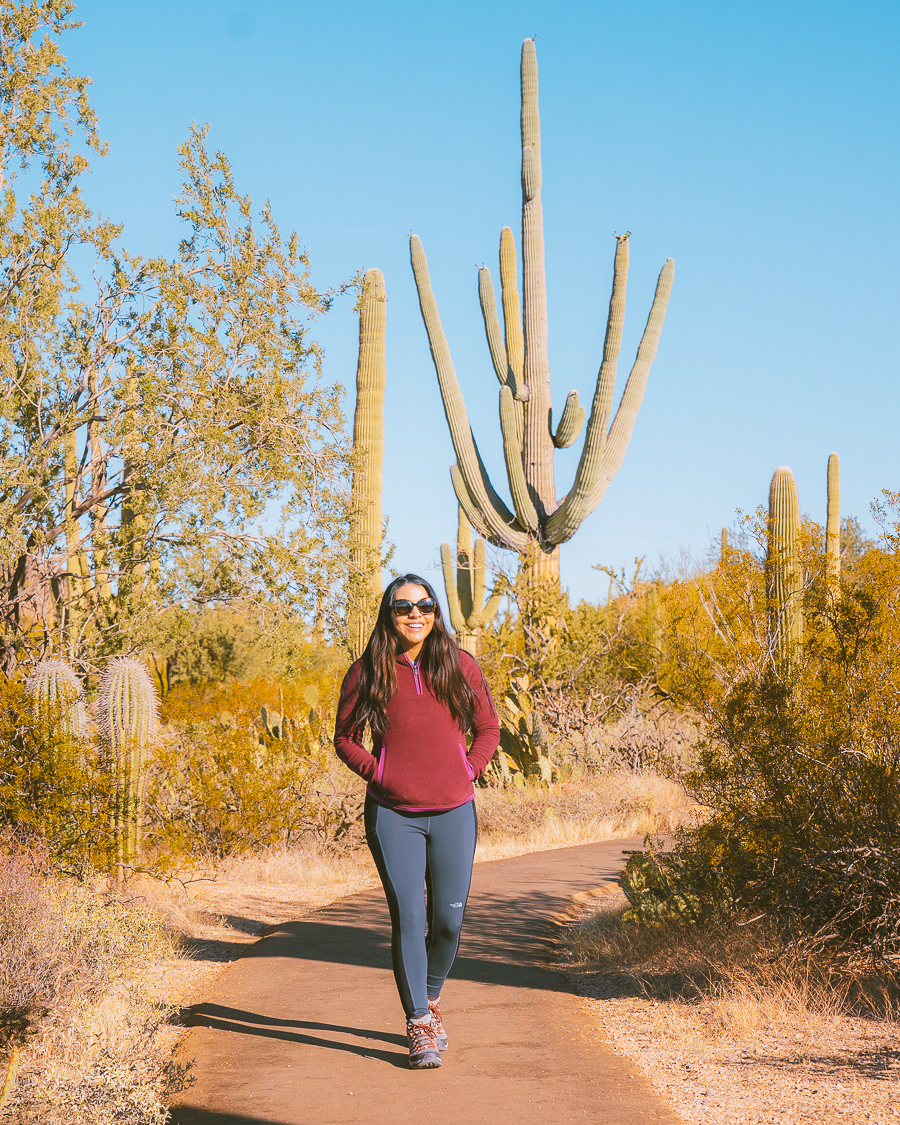
The Desert Discovery Trail is one of the shortest and easiest hikes in Saguaro National Park West. And it comes highly recommended – why? In addition to being kid-friendly, the trail allows pets to be guided on a leash and is a great starter hike for learning about desert ecology.
As you walk through the giant saguaros, you’ll come across several interpretive signs with information about the park’s habitat. Take a moment to sit on a bench under one of the shaded structures and just relish the wonder of nature.
The Desert Discovery Nature Trail also gives you epic glimpses of Avra Valley and the Baboquivari and Quinlan Mountains.
9. Take on the Cactus Forest Loop Drive
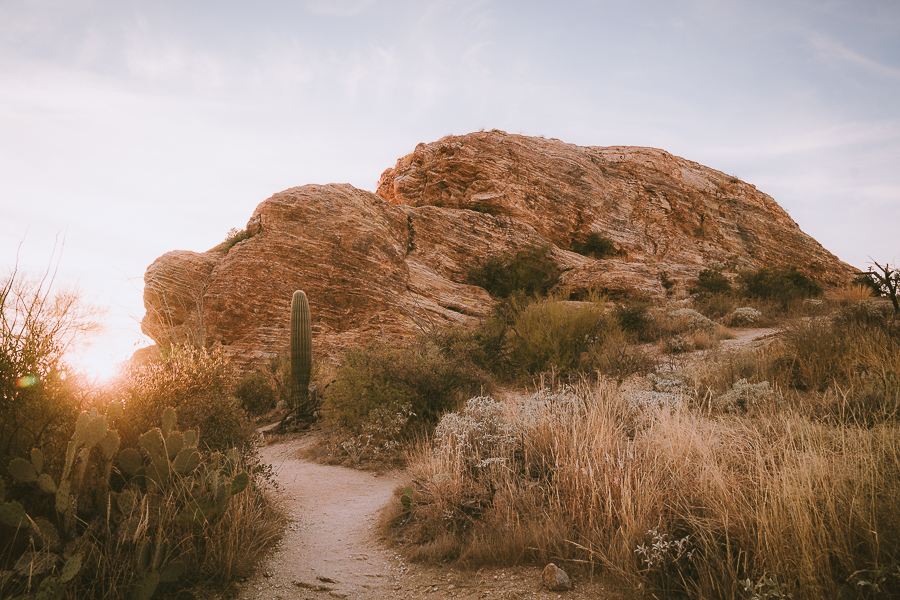
Located in Saguaro National Park East, the Cactus Forest Loop Drive is one of the most famous attractions in both sections of the park. Unlike the Bajada Loop Drive on the west side, this scenic route is paved, well-maintained, and offers more overlooks and trailheads.
The Cactus Forest Loop Drive begins right at the Rincon Mountain District Visitor Center. From there, it is up to you to either go clockwise or counterclockwise. For the sake of this guide, we’ll unpack the clockwise route.
A couple of notable spots you should consider are the Future Generations Overlook and the Sonoran Desert Overlook. Driving the Cactus Forest Loop is a great way to see most of Saguaro East, especially if you are running low on time.
10. Discover the Desert Ecology Trail
- Mileage: 0.3 miles loop
- Elevation Gain: 9.8 feet
- Difficulty: Easy
- Trail Guide: Link
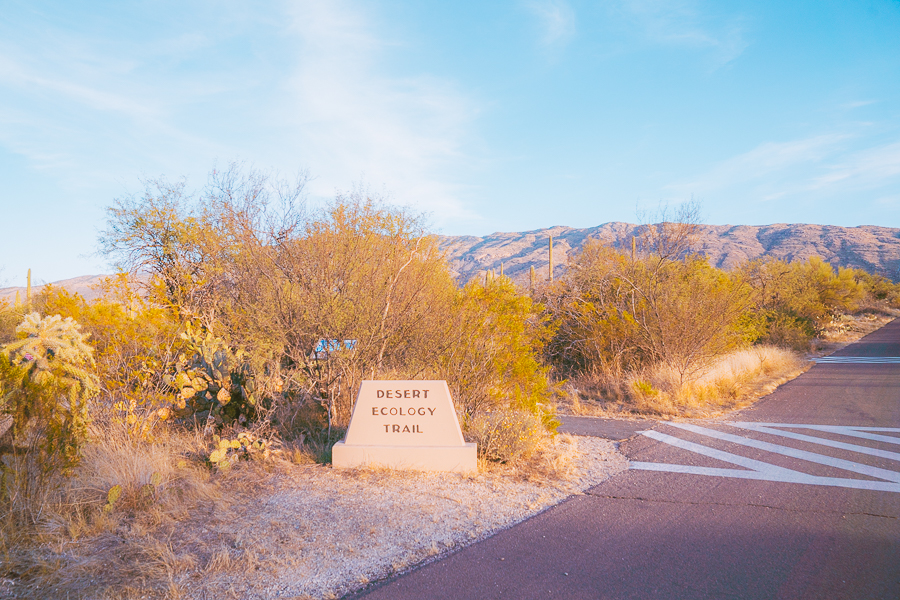
If you’re looking for a brief hike in Saguaro East that doesn’t skimp on impressive vistas, you’ll love the Desert Ecology Trail. The trailhead is located along the Cactus Forest Drive, making it very accessible.
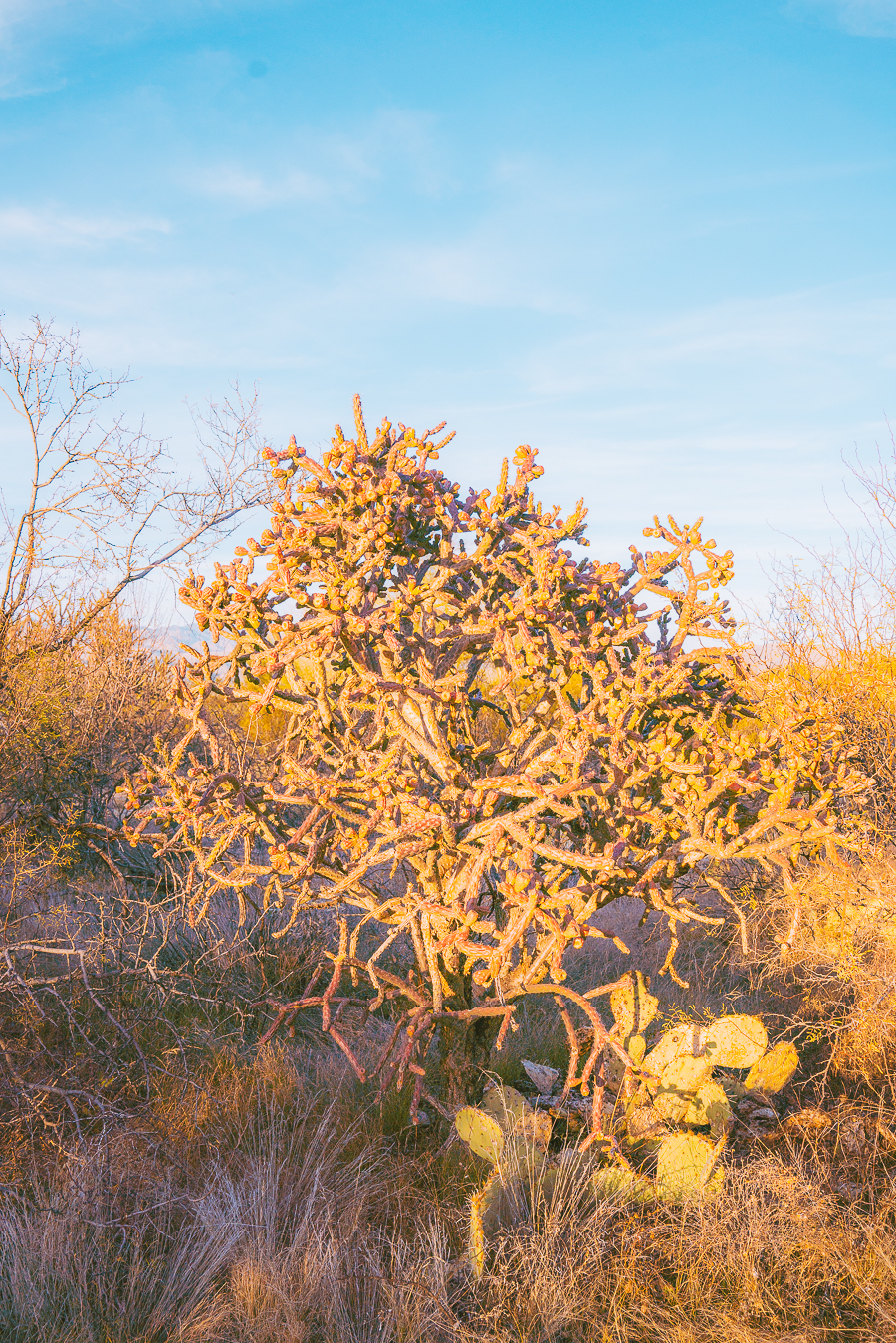
The Desert Ecology Trail is flat, entirely paved, and relatively easy to complete, making it perfect for families with small children or elderly people. Along the loop, you’ll spot many varieties of cacti, like the saguaro cactus, teddy bear cholla, prickly pear, and barrel cactus.
11. Explore the Mica View Trail
- Mileage: 1.4 miles out-and-back
- Elevation Gain: 49 feet
- Difficulty: Easy
- Trail Guide: Link
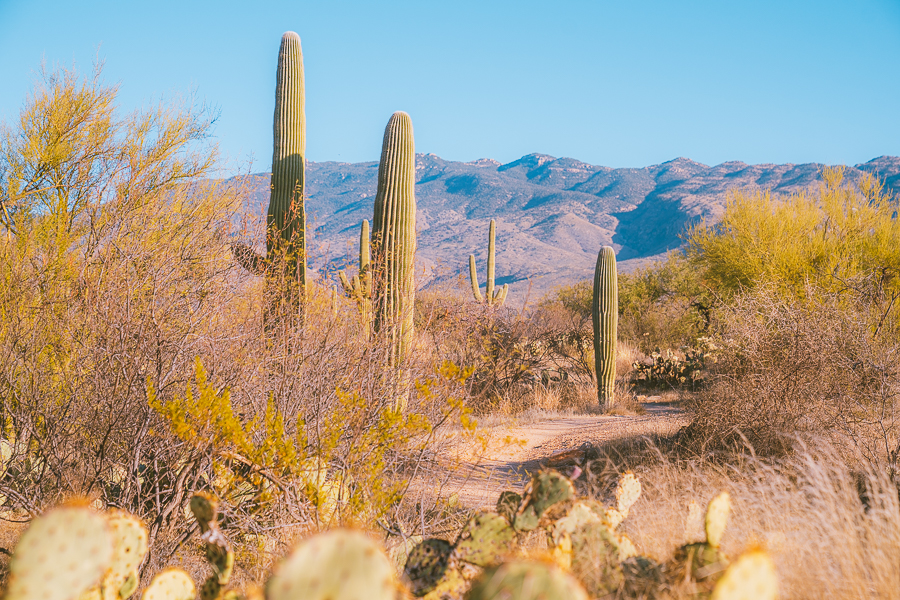
The Mica View Trail offers you some of the most mesmerizing views of the Santa Catalina and Rincon Mountains. This short, unpaved route connects two trailheads, one from Cactus Forest Drive and another located right at the park boundary on Broadway Boulevard.
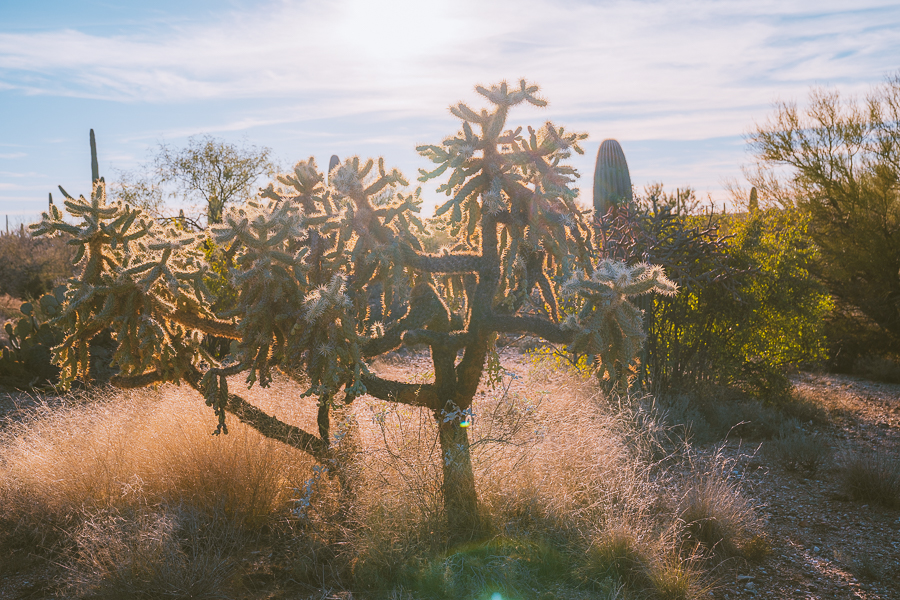
This makes the Mica View Trail one of the most popular trails in Saguaro National Park East, as it is often used as a walking or exercise route by Tucson’s local residents. It features quintessential Saguaro attractions, like cacti, dry washes, and the surrounding mountains.
12. Take on the Garwood Trail
- Mileage: 3.29 miles out-and-back
- Elevation Gain: 203 feet
- Difficulty: Easy
- Trail Guide: Link
The Garwood Trail is an excellent trek if you’re looking to explore the rugged desert foothills of the Rincon Mountains. This hike is considered relatively easy, but the somewhat long walk makes it the perfect moderate hike in Saguaro East.
This is one of a few trails in the east part of Saguaro that can be hiked in conjunction with others to make it a longer trek. You can hike the Garwood Trail towards the park’s boundary with Tucson, where you’ll also access the Douglas Spring and Wildhorse trailheads.
13. Make a Stop at Bridal Wreath Falls
- Mileage: 5.7 miles out-and-back
- Elevation Gain: 1096 feet
- Difficulty: Moderate
- Trail Guide: Link
Saguaro National Park West may be the most famous side of this national park, thanks to its densely-packed cacti, but the east side comes in first when it comes to waterfalls. Bridal Wreath Falls is a great place to cool off from the spring and summer heat while hiking in Saguaro National Park.
There are many ways for you to get to this oasis in the desert, but the most straightforward route is via the Squeeze Pen Trail, which you can access off of the Cactus Forest Drive. You can expect this trail to be one of the busiest on this side of the park, as it has some of the prettiest vegetation, occasional wildlife sightings, and beautiful views of Tucson.
Download my free Outdoor Photography Guide
14. Hike the Freeman Homestead Trail
- Mileage: 1.12 miles loop
- Elevation Gain: 108 feet
- Difficulty: Easy
- Trail Guide: Link
Saguaro East is often the side of the park people choose to visit when they are running low on time. You can think this limits one’s ability to experience the mighty saguaro cacti fully, but nothing could be farther from the truth.
The Freeman Homestead Trail is one of the best hikes you can take in Saguaro East that will give you an immersive experience. This loop trail sees you wandering along a dry wash dotted with giant saguaros and other desert vegetation.
15. Enjoy the Sunset at Javelina Rocks
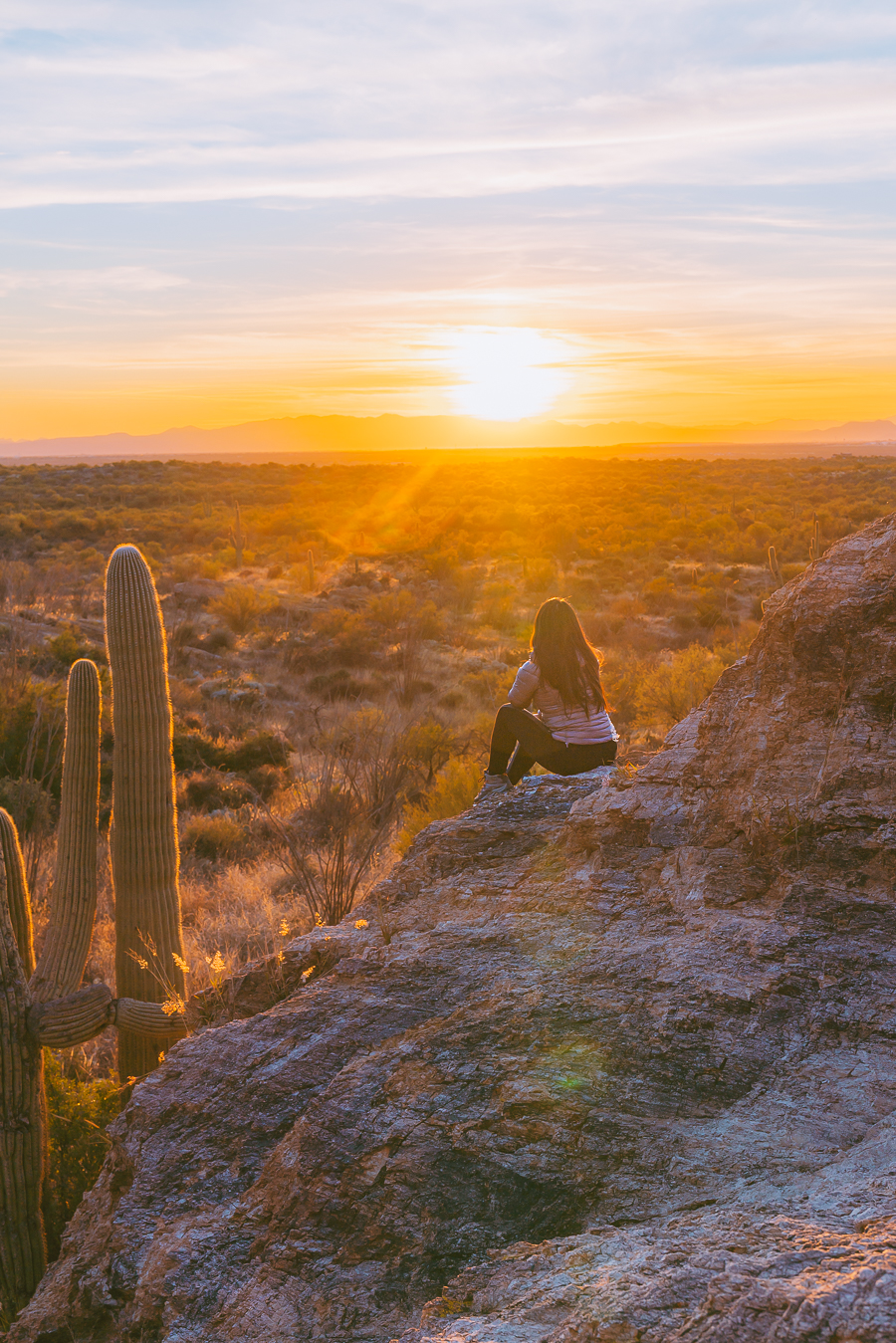
Last but certainly not least, end your day in Saguaro East with a magical sunset at Javelina Rocks. This is by far one of my favorite activities at the park, and I can’t recommend it enough. Make sure you arrive before sunset time because it is often packed.
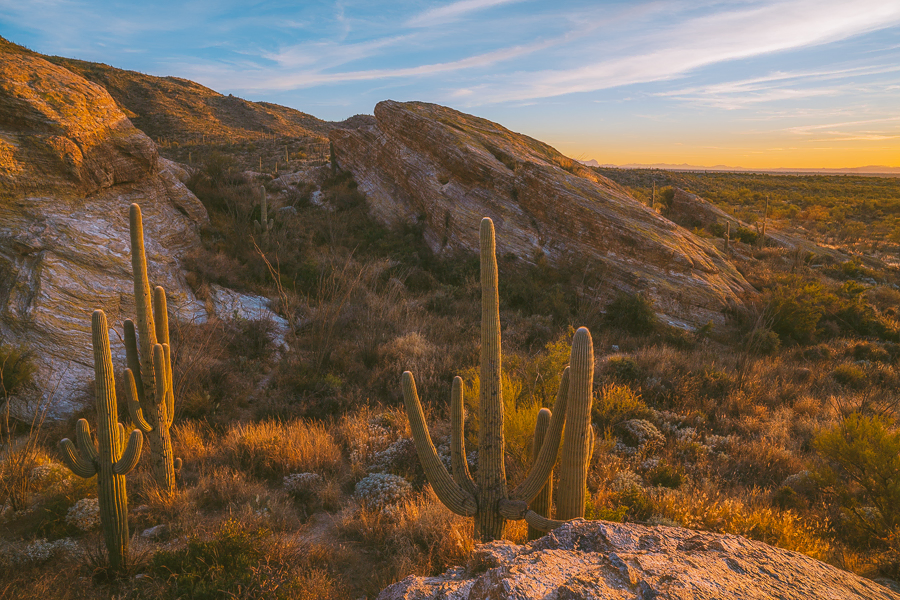
While the unforgettable sunset at Javelina Rocks takes the cup for the most beautiful views in Saguaro National Park, the attraction also draws in visitors with its elusive critters. These granite boulders are home to the javelina (or wild pig), which spends most of its time resting and feeding.
Things to Do in Saguaro National Park: FAQs
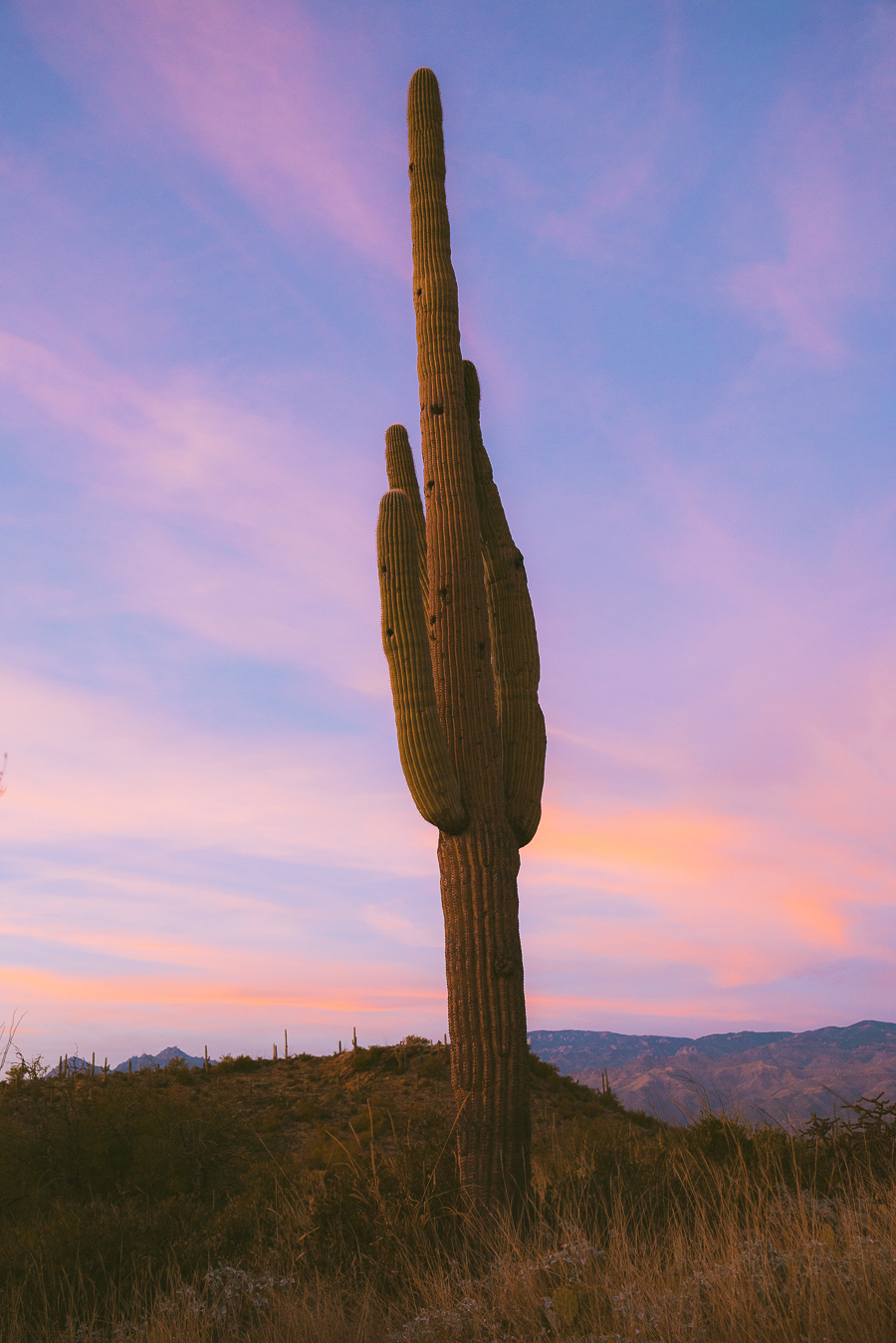
Now that you know more about the best attractions and activities you can do in Saguaro National Park, here are a few commonly asked questions you should know before you go.
What Do I Need to Know Before Going to Saguaro National Park?
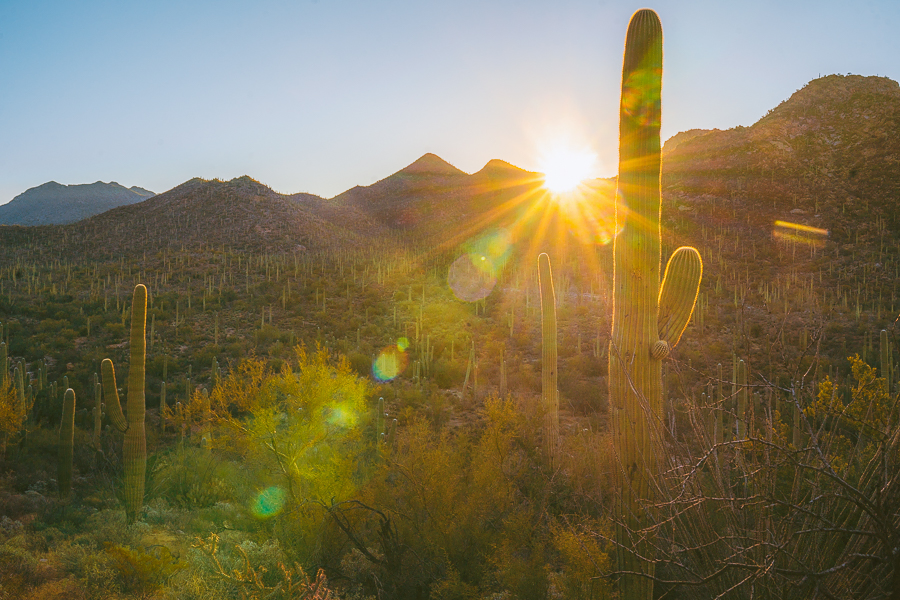
Camping in Saguaro National Park is rough and rugged. The park’s campsites (mainly in the Rincon Mountain District) do not provide for car or RV camping. All sites must be hiked to, so be prepared for a lengthy trek along towering cacti before arriving at your campsite.
Is Saguaro National Park Worth Visiting?
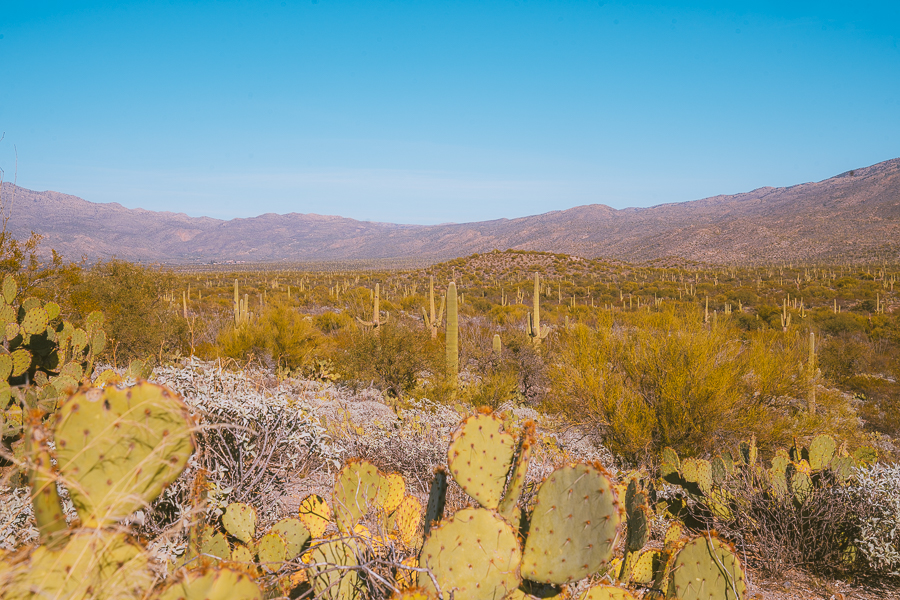
Most definitely! Saguaro National Park can easily be considered the pride of Arizona. The giant saguaro cactus is an unmissable feature on the state license plates, and that tells you all you need to know about the pride of the Southwestern state.
Are There Bears in Saguaro National Park?
Black bears are commonly sighted in Saguaro National Park, but these tend to be more prevalent in the park’s eastern district at higher elevations. The bears do occasionally head down to lower elevations in search of food, but only in extremely dry seasons.
If you happen to encounter a bear, don’t panic. These bears are typically amicable towards humans and are unlikely to attack. Remember crucial wildlife safety tips, follow due process, and you should be okay.
Wrapping Up the Best Things to Do in Saguaro National Park
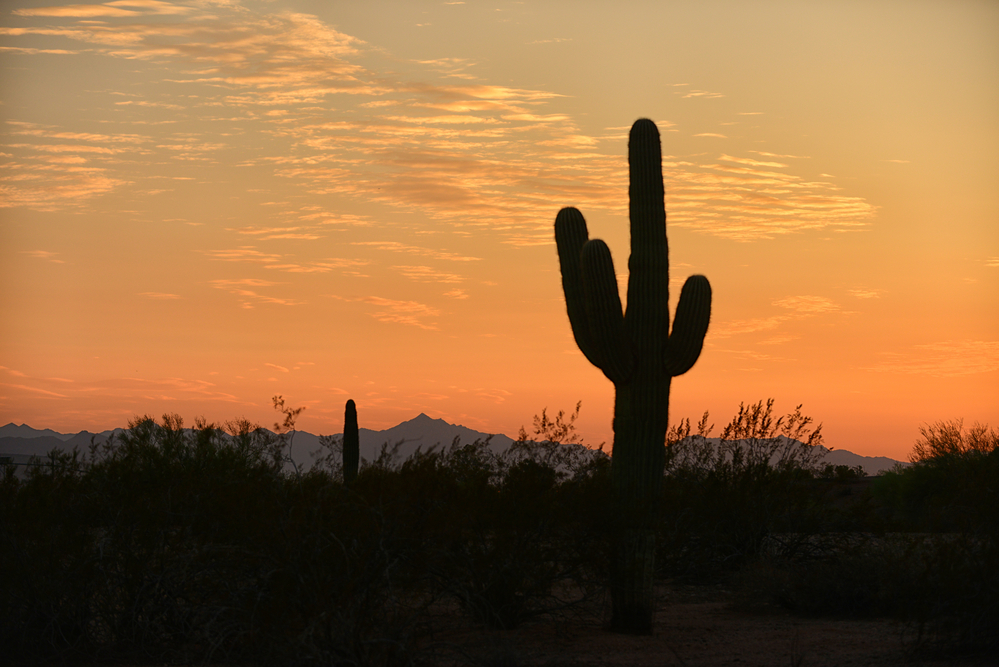
The best things to do at Saguaro National Park may have a lot to do with Arizona’s state flower, but there are plenty of other activities you’ll love. From cooling off at tumbling waterfalls along the way to catching the beautiful sunset at Saguaro National Park, you’ll find plenty of great outdoor adventures for people of all ages.
The park’s top attractions feature a perfect blend of short and long hikes, paved and dirt trails, as well as many sheltered picnic areas and rest stops to take in the amazing scenery.
Read Next: Since you’re planning a visit to the Grand Canyon State, check out these best things to do in the Grand Canyon.

